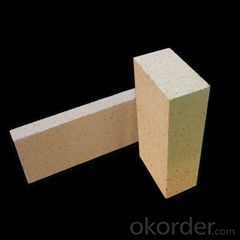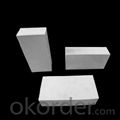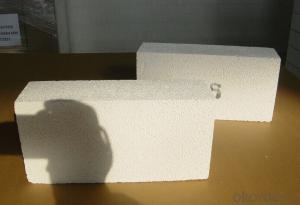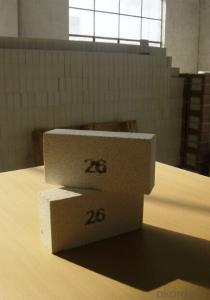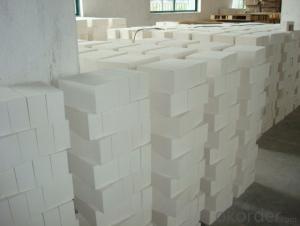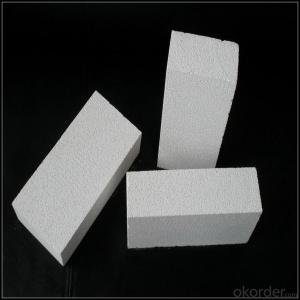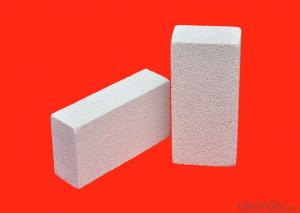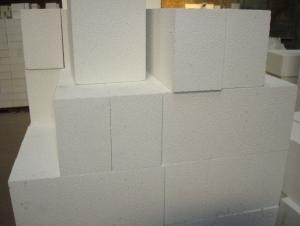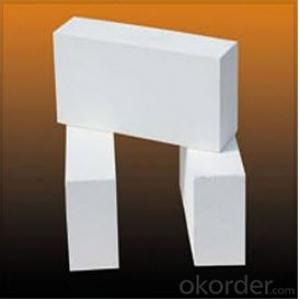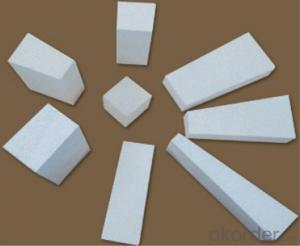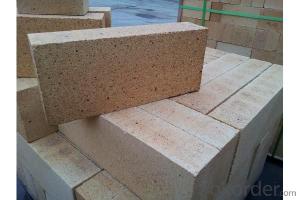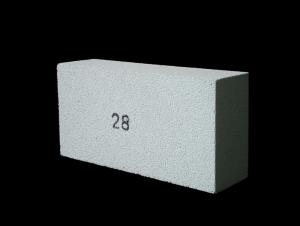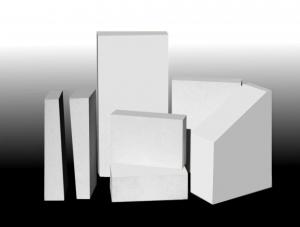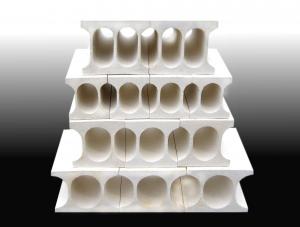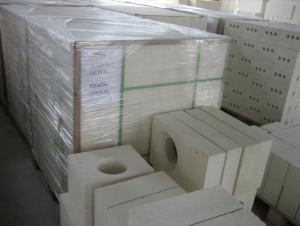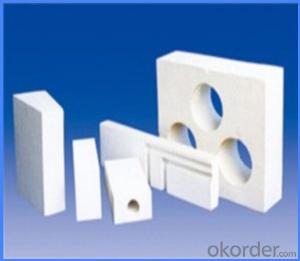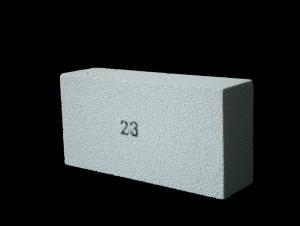Insulating Fire Brick - Mullite Lightweight Refractory White Brick
- Loading Port:
- Shanghai
- Payment Terms:
- TT OR LC
- Min Order Qty:
- 10 m.t.
- Supply Capability:
- 100 m.t./month
OKorder Service Pledge
OKorder Financial Service
You Might Also Like
Quick Details
| Place of Origin: | Brick | Refractoriness (Degree): | Common (1580°< Refractoriness< 1770°) | |
| Brand Name: |
Packaging & Delivery
| Packaging Detail: | 1.fumigated wooden pallet with polyethylene film and steel straps 2.as customers' requirements |
| Delivery Detail: | according to the contracts |
Product Description
Mullite brick is a kind of product made of best quality mullite. This product has features of good
chemical stability, high load softening temperature and good thermal shock stability, etc. It is an important kind of refractory product used in metallurgy, construction material, electric industries, etc.
Sintered Mullite Brick | |||
M-65 | M-75 | M-80 | |
Al2O3 (%) | 65 | 75 | 80 |
Refractoriness (℃) | 1850 | 1850 | 1850 |
Apparent Porosity (%) | 19 | 20 | 21 |
Bulk Density (g/cm3) | 2.5 | 2.6 | 2.7 |
Refractoriness Under Load (℃) | 1580 | 1600 | 1630 |
Atmospheric Pressure Strength(MPa) | 55 | 60 | 60 |
Light Weight Heat Insulation Brick | |||
MD-1300 | MD-1450 | MD-1550 | |
Al2O3 (%) | >40 | >50 | >65 |
SiO2 (%) | 55-60 | 40-50 | 30-35 |
Fe2O3(%) | <1 | <1 | <1 |
Host Lattice | Mullite | Mullite | Mullite |
Thermal Conductivity(w/m.k 400℃) | 0.2-0.3 | 0.2-0.3 | 0.3-0.35 |
Bulk Density (g/cm3) | 0.8-0.9 | 0.8-1.0 | 1.0-1.2 |
Atmospheric Pressure Strength (MPa) | ≥2.5 | ≥3.0 | ≥5.0 |
Refractoriness Under Load (KD℃) | >1300 | >1410 | >1520 |
Safe Working Temperature (℃) | 1300 | 1450 | 1550 |
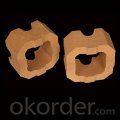
Our Services
1. We will reply to you immediately.
2. Our products will be made according to your index.
3. Other details could be discussed according to customers’ requirements.
FAQ
1. What’s the payment?
Usually T/T, others could be discussed.
2. When will you deliver the goods?
The delivery time will be determined according to the quantity of the order.
3. Do you provide samples?
Yes, samples are available.
4. How are your products’ quality?
The products will be strictly inspected before shipment, so the quality could be guaranteed.
5. Do you accept OEM?
Yes, we can do OEM.
- Q: Can insulating fire bricks be used in the construction of heat recovery systems?
- Yes, insulating fire bricks can be used in the construction of heat recovery systems. Insulating fire bricks are designed to withstand high temperatures and provide excellent thermal insulation, making them an ideal choice for heat recovery systems. These bricks are made from lightweight materials, such as ceramic fibers or refractory materials, which have low thermal conductivity. This property allows them to effectively trap and retain heat, preventing it from escaping the system and maximizing energy efficiency. Additionally, insulating fire bricks are resistant to thermal shock, meaning they can withstand rapid temperature changes without cracking or breaking. This makes them suitable for the varying heat conditions often found in heat recovery systems. Overall, using insulating fire bricks in the construction of heat recovery systems can help improve their performance and efficiency by minimizing heat loss and optimizing energy recovery.
- Q: How do insulating fire bricks affect the overall sustainability of a structure?
- The overall sustainability of a structure is greatly enhanced by the use of insulating fire bricks. These bricks are designed to provide exceptional thermal insulation, resulting in reduced heat transfer and improved energy efficiency. Their ability to minimize heat loss or gain contributes to the sustainability of a structure in various ways. To begin with, insulating fire bricks play a crucial role in reducing energy consumption by maintaining a stable indoor temperature. Their excellent insulating properties prevent heat loss in the winter and heat gain in the summer, reducing the need for heating and cooling systems. As a result, energy consumption and the associated greenhouse gas emissions are lowered. In addition, the enhanced thermal insulation provided by insulating fire bricks leads to significant cost savings. Lower energy consumption translates into reduced utility bills, making the structure economically sustainable in the long term. Furthermore, the durability and longevity of these bricks mean that replacements or repairs are less frequent, further contributing to the economic sustainability of the structure. Moreover, insulating fire bricks improve occupant comfort, which is another aspect of a sustainable structure. With better insulation, the indoor temperature remains stable, creating a more comfortable living or working environment. This reduces the need for additional heating or cooling, ultimately enhancing the overall well-being and satisfaction of the occupants. Furthermore, insulating fire bricks have a positive impact on environmental sustainability. By reducing energy consumption, these bricks contribute to the conservation of natural resources and minimize the structure's carbon footprint. The decreased reliance on fossil fuel-based energy sources helps mitigate climate change and reduce air pollution. In conclusion, insulating fire bricks have a significant positive impact on the sustainability of a structure. They reduce energy consumption, improve energy efficiency, lower costs, enhance occupant comfort, and contribute to environmental sustainability. Therefore, incorporating insulating fire bricks in the design and construction of a structure is an effective way to promote sustainability and create a more environmentally friendly and economically viable building.
- Q: Are insulating fire bricks resistant to fire damage?
- Insulating fire bricks have been specially crafted to endure fire damage. Their composition consists of unique refractory materials, enabling them to withstand exceedingly high temperatures without warping or compromising their insulation capabilities. Possessing a high melting point and low thermal conductivity, these bricks effectively insulate against heat transfer and safeguard against fire harm. Their utilization is widespread in scenarios demanding exposure to fire and elevated temperatures, including furnaces, kilns, fireplaces, and industrial procedures. In summary, insulating fire bricks exhibit reliability and durability, delivering exemplary defense against fire damage.
- Q: Are insulating fire bricks resistant to oil and gas?
- Yes, insulating fire bricks are generally resistant to oil and gas. These bricks are designed to withstand high temperatures and are commonly used in applications where they may come into contact with oil and gas, such as furnaces and kilns. However, it is important to note that the specific type and composition of the fire bricks can affect their resistance, so it is always recommended to consult the manufacturer's specifications for detailed information.
- Q: Do insulating fire bricks have a high resistance to spalling?
- Yes, insulating fire bricks have a high resistance to spalling. Spalling refers to the breaking off or flaking of the surface of a material, and in the case of fire bricks, it typically occurs due to high temperatures and thermal shock. Insulating fire bricks are specifically designed to withstand these extreme temperatures and thermal cycling, making them highly resistant to spalling. These bricks are made from high-quality refractory materials, such as alumina or silica, which have excellent thermal shock resistance. Additionally, they are manufactured with a low thermal conductivity, which helps to minimize heat transfer and reduce the risk of spalling. Overall, insulating fire bricks are an ideal choice for applications where high resistance to spalling is required, such as in furnaces, kilns, and other high-temperature environments.
- Q: Do insulating fire bricks have a high fire resistance rating?
- Insulating fire bricks possess an impressive fire resistance rating. These bricks are specifically crafted to endure elevated temperatures while providing exceptional insulation against heat transfer. They are composed of high-purity refractory materials, namely alumina and silica, which possess a high melting point and can withstand extreme heat. With the ability to endure temperatures reaching 3000°F (1650°C), insulating fire bricks exhibit significantly lower thermal conductivity compared to ordinary bricks or alternative materials. This renders them highly suitable for applications necessitating strong fire resistance, such as industrial furnaces, kilns, fireplaces, and chimneys. Moreover, their insulating properties aid in reducing heat loss, thereby promoting energy efficiency and cost-effectiveness.
- Q: Are insulating fire bricks resistant to molten metals?
- Yes, insulating fire bricks are generally resistant to molten metals. They are specifically designed to withstand high temperatures and provide insulation, making them suitable for applications involving molten metals.
- Q: Are insulating fire bricks resistant to phosphoric acid?
- Phosphoric acid, being a strong acid, has the potential to react with and corrode various materials, including fire bricks. Although certain fire bricks may possess a degree of resistance to acidic conditions, insulating fire bricks are generally not equipped to endure prolonged exposure to phosphoric acid without experiencing notable deterioration. As a result, it is advisable to employ acid-resistant materials like acid-resistant bricks or linings when handling phosphoric acid or other potent acids.
- Q: Can insulating fire bricks be used in reheating furnaces?
- Yes, insulating fire bricks can be used in reheating furnaces. Insulating fire bricks are designed to have excellent thermal insulation properties, which makes them ideal for use in high-temperature applications such as reheating furnaces. These bricks have low thermal conductivity, meaning they can effectively retain and reflect heat, resulting in energy savings and improved heating efficiency. Additionally, insulating fire bricks are lightweight and have good resistance to thermal shock, making them durable and suitable for the rapid temperature changes experienced in reheating furnaces. Overall, insulating fire bricks are a suitable choice for insulating and lining the walls of reheating furnaces, providing efficient heat retention and helping to maintain uniform temperatures throughout the furnace.
- Q: Can insulating fire bricks be used in the construction of glass bottle production furnaces?
- Yes, insulating fire bricks can be used in the construction of glass bottle production furnaces. Insulating fire bricks are designed to withstand high temperatures and provide excellent thermal insulation. They are often used in applications that require heat retention and energy efficiency, such as furnaces. By using insulating fire bricks in the construction of glass bottle production furnaces, the heat generated during the glass-making process can be effectively contained within the furnace, reducing heat loss and improving energy efficiency. This can result in cost savings and improved production performance. Additionally, insulating fire bricks can help protect the structural integrity of the furnace by minimizing thermal stress and preventing heat transfer to the surrounding environment. Overall, the use of insulating fire bricks in glass bottle production furnaces can contribute to more efficient and durable furnace operation.
Send your message to us
Insulating Fire Brick - Mullite Lightweight Refractory White Brick
- Loading Port:
- Shanghai
- Payment Terms:
- TT OR LC
- Min Order Qty:
- 10 m.t.
- Supply Capability:
- 100 m.t./month
OKorder Service Pledge
OKorder Financial Service
Similar products
Hot products
Hot Searches
Related keywords


